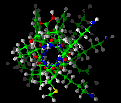 diffraction
diffraction diffraction
diffraction Jump to Description or Examples; explanation of how commands are documented.
Jump to Description or Examples; explanation of how commands are documented.
Keyword Values Default Meaning
rad*iation_type xray xray Perform calculation for X-ray radiation. electron Perform calculation for electron beam. neutron Perform calculation for neutron beam. lim*it_type q q Use q = 4sin
/
for calculation (Å-1). s Use s = 2 sin
/
(Å-1). t*heta Use scattering angle = 2
(degrees). wave*length real 0 Radiation wavelength--required only for limit_type = theta. limit_min*imum real 0 Minimum limit for q, s, or scattering angle, as appropriate. limit_max*imum real 0 Maximum limit for q, s, or scattering angle, as appropriate. frame*_definition string -- Name of file containing a specification of a Discover.arc or .his file and frames to be used. sub*set string -- Name of the atom set to be used in the analysis. The atom set must be present in the .mdf file; if not, the analysis is performed on the entire molecular system. table Boolean false Write output to a table file. file*name string run_name.tbl Name of .tbl file to receive output.
 Jump to Syntax or
Examples
Jump to Syntax or
ExamplesThe diffraction command is used to perform analysis on the current molecular system or on structures that were previously saved in .arc or .his files.
In general, it is used to perform analysis on all the atoms composing the system, and this is indicated by omitting the subset keyword and name. However, if desired, a subset of the atoms can be indicated. This is useful for reducing the computation time when the contributions of certain atoms are negligible (e.g., H atoms for X-ray scattering).
Intensities are given as I / I0, where I0
denotes the intensity at zero angle. Limits may be given in units of s
= 2 sin /
, q = 4
sin
/
, or as the
scattering angle 2
(in which case
specification of the wavelength, in angstroms, is mandatory).
The following restriction applies to the use of this command:
For details on theory and application relevant to this command, please consult the generic Diffraction pulldown documentation. This can be found in the Polymer User Guide and the Catalysis User Guide.
 Jump to Syntax or Description
Jump to Syntax or Description
diffraction frame_definition = argon.fdef \ radiation_type = xray limit_type = q \ limit_minimum = 0.1 limit_maximum = 5.0 \ +table filename = argon_xray.tblThis example of the diffraction command calculates the scattering pattern for a modeled argon system, using configurations described in the file argon.fdef. The actual configurations are stored in a .his or .arc file, as indicated in the frame definition file.
diffraction radiation_type = electron \ wavelength = 0.1 limit_type = theta \ limit_minimum = 10 limit_maximum = 60 \ +table filename = ccl4_electron.tblThis example of the diffraction command calculates the electron diffraction curve for the current system, a carbon tetrachloride molecule. The results are given as a function of the scattering angle.
 Main
access page
Main
access page  Advanced-Use access.
Advanced-Use access.
 List of BTCL commands
List of BTCL commands
 dbHandle command
dbHandle command
 dynamics command
dynamics command
Copyright Biosym/MSI